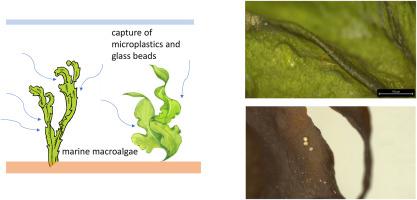当前位置:
X-MOL 学术
›
Environ. Pollut.
›
论文详情
Our official English website, www.x-mol.net, welcomes your feedback! (Note: you will need to create a separate account there.)
Biomonitoring of microplastics, anthropogenic microfibres and glass retroreflective beads by marine macroalgae
Environmental Pollution ( IF 8.9 ) Pub Date : 2024-03-23 , DOI: 10.1016/j.envpol.2024.123801 Cerys Rimmer , Jodie Fisher , Andrew Turner
Environmental Pollution ( IF 8.9 ) Pub Date : 2024-03-23 , DOI: 10.1016/j.envpol.2024.123801 Cerys Rimmer , Jodie Fisher , Andrew Turner

|
Microplastics and other microscopic debris are a concern in the coastal environment but measurements in the water column and sediment are often problematic and rely on non-standardised and highly variable methodologies. To this end, we explore the potential of different species of temperate-cold marine macroalgae as passive biomonitors of anthropogenic microparticles at three contrasting locations in southwest England. Specifically, fronds from samples of fucoids and ( = 9 in total, and three from each location) have been sectioned and analysed directly under a microscope and anthropogenic microparticles counted and subsequently characterised for chemical composition. Microparticles were heterogeneously distributed throughout sections from the same sample. However, on a dry weight basis, combined microparticle concentrations for each sample ranged from about 7.5 g to 110 g, and from about 0.2 cm to 0.9 cm, and for a given species were higher in samples from a semi-enclosed harbour and urban beach than in samples from a protected beach facing the open sea. These values compare with published concentrations of microplastics and microfibres reported for the regional water column on the order of 0.1 m. Most particles were cellulosic (e.g., rayon) and petroleum-based (mainly polyester and polyethylene terephthalate) fibres but plastic fragments were also present on most samples. Glass retroreflective beads derived from road markings were also present at up to 18 g on fucoids from the urban beach because of its proximity to a stormwater effluent. Most microparticles were adhered to the smooth parts of the macroalgal surface but some displayed wrapping around edges and creases or entrapment by appendages. The practical and environmental implications of macroalgae passively capturing significant quantities of anthropogenic microparticles are discussed.
中文翻译:

海洋大型藻类对微塑料、人为微纤维和玻璃反光珠的生物监测
微塑料和其他微观碎片是沿海环境中的一个问题,但水柱和沉积物中的测量通常存在问题,并且依赖于非标准化和高度可变的方法。为此,我们在英格兰西南部三个不同的地点探索了不同种类的温带寒冷海洋大型藻类作为人为微粒被动生物监测器的潜力。具体来说,岩藻类样品的叶状体(总共 = 9 个,每个位置三个)已直接在显微镜下切片和分析,并对人为微粒进行计数并随后表征其化学成分。微粒在同一样品的各个切片中不均匀地分布。然而,以干重计,每个样品的组合微粒浓度范围为约 7.5 克至 110 克,范围为约 0.2 厘米至 0.9 厘米,对于给定物种,来自半封闭港口和城市海滩的样品中的微粒浓度较高比来自面向公海的受保护海滩的样本。这些值与已公布的区域水柱中 0.1 m 量级的微塑料和微纤维浓度进行了比较。大多数颗粒是纤维素(例如人造丝)和石油基(主要是聚酯和聚对苯二甲酸乙二醇酯)纤维,但大多数样品上也存在塑料碎片。由于城市海滩靠近雨水排放物,来自道路标记的玻璃反光珠在来自城市海滩的岩藻类中也含量高达 18 克。大多数微粒粘附在大型藻类表面的光滑部分上,但有些微粒显示出围绕边缘和折痕的包裹或被附属物捕获。讨论了大型藻类被动捕获大量人为微粒的实际和环境影响。
更新日期:2024-03-23
中文翻译:

海洋大型藻类对微塑料、人为微纤维和玻璃反光珠的生物监测
微塑料和其他微观碎片是沿海环境中的一个问题,但水柱和沉积物中的测量通常存在问题,并且依赖于非标准化和高度可变的方法。为此,我们在英格兰西南部三个不同的地点探索了不同种类的温带寒冷海洋大型藻类作为人为微粒被动生物监测器的潜力。具体来说,岩藻类样品的叶状体(总共 = 9 个,每个位置三个)已直接在显微镜下切片和分析,并对人为微粒进行计数并随后表征其化学成分。微粒在同一样品的各个切片中不均匀地分布。然而,以干重计,每个样品的组合微粒浓度范围为约 7.5 克至 110 克,范围为约 0.2 厘米至 0.9 厘米,对于给定物种,来自半封闭港口和城市海滩的样品中的微粒浓度较高比来自面向公海的受保护海滩的样本。这些值与已公布的区域水柱中 0.1 m 量级的微塑料和微纤维浓度进行了比较。大多数颗粒是纤维素(例如人造丝)和石油基(主要是聚酯和聚对苯二甲酸乙二醇酯)纤维,但大多数样品上也存在塑料碎片。由于城市海滩靠近雨水排放物,来自道路标记的玻璃反光珠在来自城市海滩的岩藻类中也含量高达 18 克。大多数微粒粘附在大型藻类表面的光滑部分上,但有些微粒显示出围绕边缘和折痕的包裹或被附属物捕获。讨论了大型藻类被动捕获大量人为微粒的实际和环境影响。



























 京公网安备 11010802027423号
京公网安备 11010802027423号